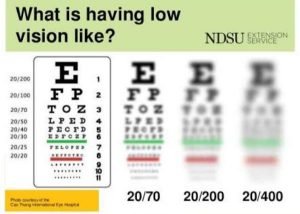The most common types of low vision include:
Loss of central vision: There is a blind spot in the center of one's vision.
Loss of peripheral (side) vision: The inability to see anything to either side, above, or below eye level. Central vision, however, remains intact.
Night blindness : The inability to see in poorly lit areas such as theaters, as well as outside at night.
Blurred vision: Objects both near and far appear out of focus.
Hazy vision: The entire field of vision appears to be covered with a film or glare.
What causes low vision?
There may be one or more causes of low vision. These are usually the result of disorders or injuries affecting the eye or a disorder such as diabetes that affects the entire body. Some of the most common causes of low vision include age-related macular degeneration, diabetes, 
and glaucoma. Low vision may also result from cancer of the eye, albinism, brain injury, or inherited disorders of the eye including retinitis pigmentosa. If you have these disorders or are at risk for them, you are also at greater risk for low vision.
Posted from my blog with SteemPress : http://www.health-today.gq/?p=52
Source
Plagiarism is the copying & pasting of others work without giving credit to the original author or artist. Plagiarized posts are considered spam.
Spam is discouraged by the community, and may result in action from the cheetah bot.
More information and tips on sharing content.
If you believe this comment is in error, please contact us in #disputes on Discord
Downvoting a post can decrease pending rewards and make it less visible. Common reasons:
Submit
Hi! I am a robot. I just upvoted you! I found similar content that readers might be interested in:
https://my.clevelandclinic.org/health/diseases/8585-low-vision
Downvoting a post can decrease pending rewards and make it less visible. Common reasons:
Submit